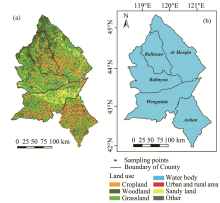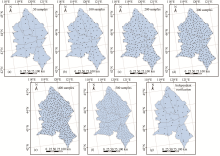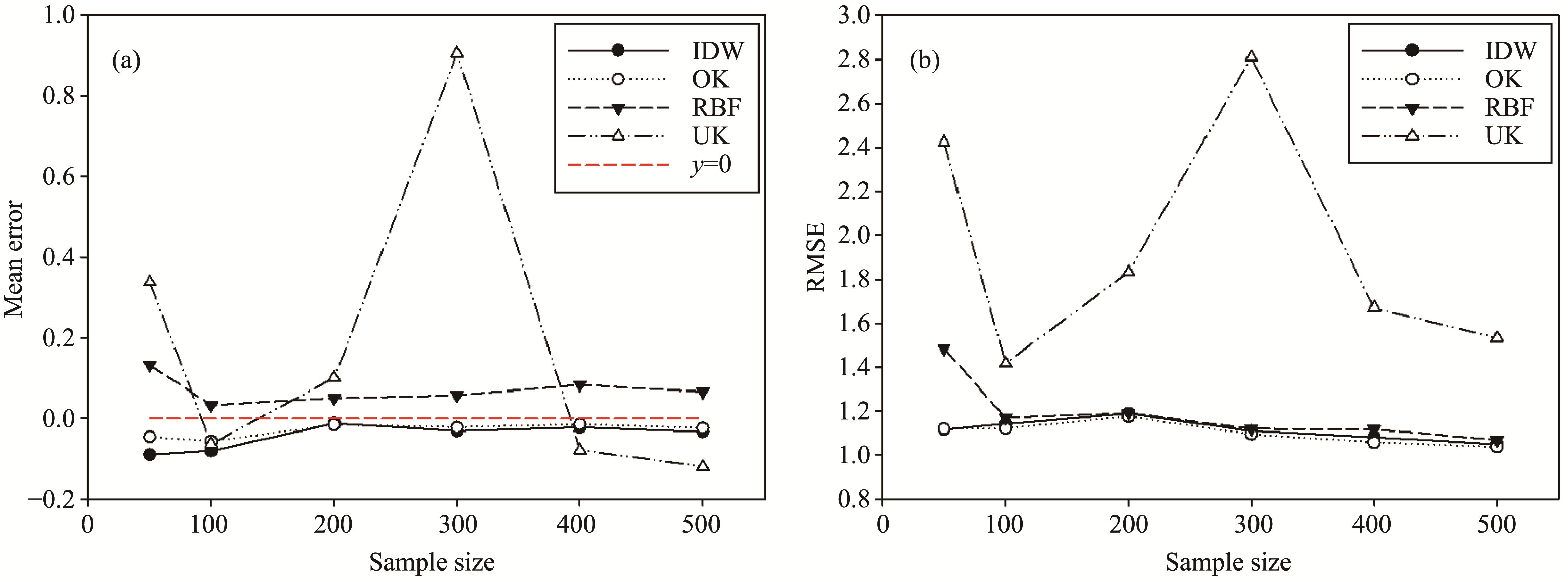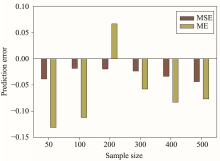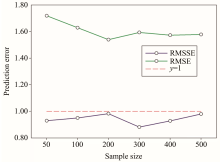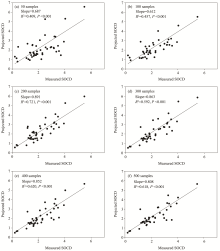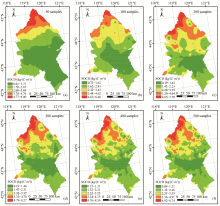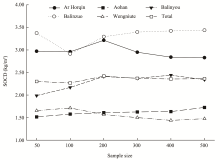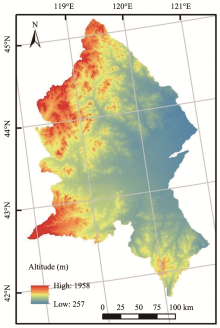Sciences in Cold and Arid Regions ›› 2020, Vol. 12 ›› Issue (4): 200–216.doi: 10.3724/SP.J.1226.2020.00217.
Comparison of sampling schemes for spatial prediction of soil organic carbon in Northern China
XuYang Wang1,2,YuQiang Li1,2,3( ),YuLin Li1,2,3,YinPing Chen4,Jie Lian1,2,WenJie Cao4
),YuLin Li1,2,3,YinPing Chen4,Jie Lian1,2,WenJie Cao4
- 1.Northwest Institute of Eco-Environment and Resources, Chinese Academy of Sciences, Lanzhou, Gansu 730000, China
2.University of Chinese Academy of Sciences, Beijing 100049, China
3.Naiman Desertification Research Station, Northwest Institute of Eco-Environment and Resources, Chinese Academy of Sciences, Tongliao, Inner Mongolia 028300, China
4.School of Environmental and Municipal Engineering, Lanzhou Jiaotong University, Lanzhou, Gansu 730070, China
|
Bhunia GS, Shit PK, Maiti R, 2016. Comparison of GIS-based interpolation methods for spatial distribution of soil organic carbon (SOC). Journal of the Saudi Society of Agricultural, 17(2): 114-126. DOI: 10.1016/j.jssas.2016.02.001.
doi: 10.1016/j.jssas.2016.02.001 |
|
| Blake GR, Hartge H, 1986. Bulk Density. In: Madison. Methods of Soil Analysis, Part1: Physical and Mineralogical Methods. USA: American Society of Agronomy Press, pp. 365-375. | |
|
Boivin P, Gascuel OC, 1994. Variability of variograms and spatial estimates due to soil sampling: a case study. Geoderma, 62: 165-182. DOI: 10.1016/0016-7061(94)90034-5.
doi: 10.1016/0016-7061(94)90034-5 |
|
|
Bourennane H, King D, Couturier A, 2000. Comparison of kriging with external drift and simple linear regression for predicting soil horizon thickness with different sample densities. Geoderma, 97: 255-271. DOI: 10.1016/S0016-7061(00)00042-2.
doi: 10.1016/S0016-7061(00)00042-2 |
|
|
Bradford MA, Tordoff GM, Black HIJ, et al., 2007. Carbon dynamics in a model grassland with functionally different soil communities. Functional Ecology, 21: 690-697. DOI: 10. 1111/j.1365-2435.2007.01268.x.
doi: 10. 1111/j.1365-2435.2007.01268.x |
|
|
Cambardella CA, 1994. Field-scale variability of soil properties in central Iowa soils. Soil Science Society of America Journal, 58: 1501-1511. DOI: 10.2136/sssaj1994.03615995005800050033x.
doi: 10.2136/sssaj1994.03615995005800050033x |
|
|
Chen T, Liu XM, Li X, et al., 2009. Heavy metal sources identification and sampling uncertainty analysis in a field-scale vegetable soil of Hangzhou, China. Environmental Pollution, 157: 1003-1010. DOI: 10.1016/j.envpol.2008. 10.011.
doi: 10.1016/j.envpol.2008. 10.011 |
|
| Cools N, De Vos B, 2010. Sampling and Analysis of Soil. Manual Part X, In: Manual on methods and criteria for harmonized sampling, assessment, monitoring and analysis of the effects of air pollution on forests, United Nations Economic Commission for Europe (UNECE), ICP Forests, Hamburg. | |
|
Don A, Schumacher J, Scherer M, 2007. Spatial and vertical variation of soil carbon at two grassland sites-Implications for measuring soil carbon stocks. Geoderma, 141: 272-282. DOI: 10.1016/j.geoderma.2007.06.003.
doi: 10.1016/j.geoderma.2007.06.003 |
|
|
Fathian F, Aliyari H, Kahya E, et al., 2015. Temporal trends in precipitation using spatial techniques in GIS over Urmia Lake Basin, Iran. International Journal of Hydrology Science & Technology, 6 (1): 62-81. DOI: 10.1504/IJHST. 2016.073883.
doi: 10.1504/IJHST. 2016.073883 |
|
|
Gao P, Wang B, Geng GP, et al., 2013. Spatial distribution of soil organic carbon and total nitrogen based on GIS and geostatistics in a small watershed in a hilly area of northern China. Plos One, 8: e83592. DOI: 10.1371/journal.pone. 0083592.
doi: 10.1371/journal.pone. 0083592 |
|
|
Göl C, Bulut S, Bolat F, 2017. Comparison of different interpolation methods for spatial distribution of soil organic carbon and some soil properties in the Black Sea backward region of Turkey. Journal of African Earth Sciences, 134: 85-91. DOI: 10.1016/j.jafrearsci.2017.06.014.
doi: 10.1016/j.jafrearsci.2017.06.014 |
|
|
Heim A, Wehrli L, Eugster W, et al., 2009. Effects of sampling design on the probability to detect soil carbon stock changes at the Swiss CarboEurope site Lägeren. Geoderma, 149: 347-354. DOI: 10.1016/j.geoderma.2008.12.018.
doi: 10.1016/j.geoderma.2008.12.018 |
|
| Houghton JET, Ding YH, Griggs DJ, 2001. IPCC2001. Climate Change 2001: the Scientific Basis. Cambridge University Press, Cambridge, U.K.. pp. 227-239. | |
|
Houghton RA, Woodwell GM, Sedjo RA, 1988. The global carbon cycle. American Scientist, 241: 1736-1738. DOI: 10. 1126/science.241.4874.1736-b.
doi: 10. 1126/science.241.4874.1736-b |
|
|
Kerry R, Oliver MA, 2007. Comparing sampling needs for variograms of soil properties computed by the method of moments and residual maximum likelihood. Geoderma, 140: 383-396. DOI: 10.1016/j.geoderma.2007.04.019.
doi: 10.1016/j.geoderma.2007.04.019 |
|
|
Khalil MI, Kiely G, O'Brien P, et al., 2013. Organic carbon stocks in agricultural soils in Ireland using combined empirical and GIS approaches. Geoderma, 193-194: 222-235. DOI: 10.1016/j.geoderma.2012.10.005.
doi: 10.1016/j.geoderma.2012.10.005 |
|
|
Kumar S, Lal R, Liu D, 2012. A geographically weighted regression kriging approach for mapping soil organic carbon stock. Geoderma, 189-190: 627-634. DOI: 10.1016/j.geoderma.2012.05.022.
doi: 10.1016/j.geoderma.2012.05.022 |
|
|
Li D, Shao MA, 2014. Soil organic carbon and influencing factors in different landscapes in an arid region of northwestern China. Catena, 116: 95-104. DOI: 10.1016/j.catena. 2013.12.014.
doi: 10.1016/j.catena. 2013.12.014 |
|
|
Lal R, 2008. Carbon sequestration. Philos. Trans. R. Soc. London, Ser. B, 363: 815-830. DOI: 10.1098/rstb.2007.2185.
doi: 10.1098/rstb.2007.2185 |
|
|
Lal R, 2004. Soil carbon sequestration impacts on global climate change and food security. Science, 304: 1623-1627. DOI: 10.1126/science.1097396.
doi: 10.1126/science.1097396 |
|
|
Li FR, Zhao LY, Zhang H, et al., 2004. Wind erosion and airborne dust deposition in farmland during spring in the Horqin Sandy Land of eastern Inner Mongolia, China. Soil & Tillage Research, 75: 121-130. DOI: 10.1016/j.still. 2003.08.001.
doi: 10.1016/j.still. 2003.08.001 |
|
| Li FR, Zhou ZY, Zhao LY,et al., 2007. Efficacy of exclosures in conserving local shrub biodiversity in xeric sandy grassland, Mongolia Inner, China. In: Sosebee RE, Wester DB, Britton CM, McArthur ED, Kitchen SG (eds.). Proceedings: Shrubland dynamics-fire and water. Fort Collins, CO: U. | |
| S. Department of Agriculture, Forest Service, Rocky Mountain Research Station, pp. 163-169. | |
|
Li Y, Zhou S, Wu CF, et al., 2007. Improved prediction and reduction of sampling density for soil salinity by different geostatistical methods. Agricultural Sciences in China, 6: 832-841. DOI: 10.1016/s1671-2927(07)60119-9. (in Chinese)
doi: 10.1016/s1671-2927(07)60119-9 |
|
|
Liao QL, Zhang XH, Li ZP, et al., 2009. Increase in soil organic carbon stock over the last two decades in China's Jiangsu Province. Global Change Biology, 15: 861-875. DOI: 10.1111/j.1365-2486.2008.01792.x.
doi: 10.1111/j.1365-2486.2008.01792.x |
|
|
Liu X, Wu J, Xu J, 2006. Characterizing the risk assessment of heavy metals and sampling uncertainty analysis in paddy field by geostatistics and GIS. Environmental Pollution, 141: 257. DOI: 10.1016/j.envpol.2005.08.048.
doi: 10.1016/j.envpol.2005.08.048 |
|
|
Mai JS, Zhao TN, Zheng JK, et al., 2015. Spatial variability of surface soil nutrients in the landslide area of Beichuan County, Southwestern China, after5.12 Wenchuan Earthquake. Chinese Journal of Applied Ecology, 26: 3588-3594. DOI: Y2015/V26/I12/3588. (in Chinese)
doi: Y2015/V26/I12/3588 |
|
|
McBratney AB, Webster R, 1983. How many observations are needed for regional estimation of soil properties? Soil Science, 135: 177-183. DOI: 10.1097/00010694-198303000-00007.
doi: 10.1097/00010694-198303000-00007 |
|
|
Mishra U, Lal R, Liu D, et al., 2010. Predicting the spatial variation of the soil organic carbon pool at a regional scale. Soil Science Society of America Journal, 74: 906-914. DOI: 10.2136/sssaj2009.0158.
doi: 10.2136/sssaj2009.0158 |
|
|
Mueller T, 2003. Soil carbon maps: Enhancing spatial estimates with simple terrain attributes at multiple scales. Soil Science Society of America Journal, 67: 258-267. DOI: 10.2136/sssaj2003.0258.
doi: 10.2136/sssaj2003.0258 |
|
|
Neff JC, Townsend AR, Gleixner G, et al., 2002. Variable effects of nitrogen additions on the stability and turnover of soil carbon. Nature, 419: 915-917. DOI: 10.1038/nature01136.
doi: 10.1038/nature01136 |
|
| Nelson DW, Sommers LE, 1982. Total carbon, organic carbon and organic matter. In: Page AL, Miller RH, Keeney DR (ed.). Methods of Soil Analysis, Part2, 2nd ed., American Society of Agronomy, Madison, WI, USA, pp. 539-577. | |
|
Nelson DW, 1996. Total carbon, organic carbon, and organic matter. Methods of Soil Analysis, 9: 961-1010. DOI: 10. 2136/sssabookser5.3.c34.
doi: 10. 2136/sssabookser5.3.c34 |
|
|
Zhang ZQ, Yu DS, Shi XZ, et al., 2015. Priority selection rating of sampling density and interpolation method for detecting the spatial variability of soil organic carbon in China. Environment Earth Sciences, 73: 2287-2297. DOI: 10.1007/s12665-014-3580-3.
doi: 10.1007/s12665-014-3580-3 |
|
|
Reza SK, Baruah U, Sarkar D, 2016. Spatial variability of soil properties using geostatistical method: a case study of lower Brahmaputra plains, India. Arabian Journal of Geosciences, 9: 1-8. DOI: 10.1007/s12517-016-2474-y.
doi: 10.1007/s12517-016-2474-y |
|
|
Rozpondek R, Wancisiewicz K, 2016. Distribution of pollution in sediments in the coastal zone of Ostrowy water reservoir in Biała Oksza river-GIS based approach. Environment Protection Engineering, 19: 37-49. DOI: 10.17512/ios. 2016.1.4.
doi: 10.17512/ios. 2016.1.4 |
|
|
Sahrawat KL, Rego TJ, Wani SP, et al., 2008. Stretching soil sampling to watershed: evaluation of soil‐test parameters in a semi‐arid tropical watershed. Commun, Communications in Soil Science & Plant Analysis, 39: 2950-2960. DOI: 10.1080/00103620802432857.
doi: 10.1080/00103620802432857 |
|
|
Sandeep K, 2015. Estimating spatial distribution of soil organic carbon for the Midwestern United States using historical database. Chemosphere, 127: 49-57. DOI: 10.1016/j.chemosphere.2014.12.027.
doi: 10.1016/j.chemosphere.2014.12.027 |
|
|
Schloeder CA, Zimmerman NE, Jacobs MJ, 2001. Comparison of methods for interpolating soil properties using limited data. Soil Science Society of America Journal, 65: 470-479. DOI: 10.2136/sssaj2001.652470x.
doi: 10.2136/sssaj2001.652470x |
|
|
Shit PK, Bhunia GS, Maiti R, 2016. Spatial analysis of soil properties using GIS based geostatistics models. Modeling Earth Systems & Environment, 2: 1-6. DOI: 10.1007/s40808-016-0160-4.
doi: 10.1007/s40808-016-0160-4 |
|
|
Simbahan GC, Dobermann A, 2006. Sampling optimization based on secondary information and its utilization in soil carbon mapping. Geoderma, 133: 345-362. DOI: 10.1016/j.geoderma.2005.07.020.
doi: 10.1016/j.geoderma.2005.07.020 |
|
|
Steffens M, Kölbl A, Giese M, et al., 2009. Spatial variability of topsoils and vegetation in a grazed steppe ecosystem in Inner Mongolia (PR China). Journal of Plant Nutrition and Soil Science, 172: 78-90. DOI: 10.1002/jpln.200700309.
doi: 10.1002/jpln.200700309 |
|
|
Sun W, Zhao Y, Huang B, et al., 2012. Effect of sampling density on regional soil organic carbon estimation for cultivated soils. Journal of Plant Nutrition and Soil Science, 175: 671-680. DOI: 10.1002/jpln.201100181.
doi: 10.1002/jpln.201100181 |
|
|
Tao D, Singh N, Goswami C, 2018. Spatial variability of soil organic carbon and available nutrients under different topography and land uses in Meghalaya, India. International Journal of Plant & Soil Science, 21: 1-16. DOI: 10.9734/ijpss/2018/39615.
doi: 10.9734/ijpss/2018/39615 |
|
|
Wang J, Yang R, Feng Y, 2017. Spatial variability of reconstructed soil properties and the optimization of sampling number for reclaimed land monitoring in an opencast coal mine. Arabian Journal of Geosciences, 10: 46. DOI: 10.1007/s12517-017-2836-0.
doi: 10.1007/s12517-017-2836-0 |
|
|
Wang J, Yang R, Bai Z, 2015. Spatial variability and sampling optimization of soil organic carbon and total nitrogen for minesoils of the Loess Plateau using geostatistics. Ecological Engineering, 82: 159-164. DOI: 10.1016/j.ecoleng. 2015.04.103.
doi: 10.1016/j.ecoleng. 2015.04.103 |
|
| Wang T, Han P, Wu SB, et al., 2011. Deserts and Aeolian Desertification in China. Science Press, pp. 24. | |
|
Wang T, Wu W, Zhao HL, et al., 2004. Analyses on driving factors to sandy desertification process in Horqin Region, China. Journal of Desert Research, 135: 348-357. DOI: 10.1111/j.1365-2249.2004.02384.x. (in Chinese)
doi: 10.1111/j.1365-2249.2004.02384.x |
|
|
Webster R, Oliver MA, 1992. Sample adequately to estimate variograms of soil properties. European Journal of Soil Science, 43: 177-192. DOI: 10.1111/j.1365-2389.1992.tb00128.x.
doi: 10.1111/j.1365-2389.1992.tb00128.x |
|
| Webster R, Oliver MA, 2007. Geostatistics for Environmental Scientists, Second Edition. Statistics for Earth and Environmental Scientists, pp. 271. | |
|
Were K, Bui DT, Dick OB, et al., 2015. A comparative assessment of support vector regression, artificial neural networks, and random forests for predicting and mapping soil organic carbon stocks across an Afromontane landscape. Ecological Indicators, 52: 394-403. DOI: 10.1016/j.ecolind.2014.12.028.
doi: 10.1016/j.ecolind.2014.12.028 |
|
|
Wiesmeier M, Spörlein P, Geuß U, et al., 2012. Soil organic carbon stocks in southeast Germany (Bavaria) as affected by land use, soil type and sampling depth. Global Change Biology, 18: 2233-2245. DOI: 10.1111/j.1365-2486.2012. 02699.x.
doi: 10.1111/j.1365-2486.2012. 02699.x |
|
|
Wiesmeier M, Hübner R, Barthold F, et al., 2013. Amount, distribution and driving factors of soil organic carbon and nitrogen in cropland and grassland soils of southeast Germany (Bavaria). Agriculture, Ecosystems & Environment, 176: 39-52. DOI: 10.1016/j.agee.2013.05.012.
doi: 10.1016/j.agee.2013.05.012 |
|
|
Wilson BR, Koen TB, Barnes P, et al., 2011. Soil carbon and related soil properties along a soil type and land-use intensity gradient, New South Wales, Australia. Soil Use & Management, 27: 437-447. DOI: 10.1111/j.1475-2743.2011. 00357.x.
doi: 10.1111/j.1475-2743.2011. 00357.x |
|
|
Zhang C, Liu G, Xue S, et al., 2013. Soil organic carbon and total nitrogen storage as affected by land use;in a small watershed of the Loess Plateau, China. European Journal of Soil Biology, 54: 16-24. DOI: 10.1016/j.ejsobi.2012. 10.007.
doi: 10.1016/j.ejsobi.2012. 10.007 |
|
|
Yang R, Su Y, Wang M, et al., 2013. Field-scale spatial and temporal variation of soil organic carbon in a reclaimed sandy farmland. Journal of Desert Research, 33: 1078-1083. DOI: 210.72.80.159. (in Chinese)
doi: 210.72.80.159 |
|
|
Yasrebi J, Saffari M, Fathi H, et al., 2012. Evaluation and comparison of Ordinary Kriging and Inverse Distance Weighting methods for prediction of spatial variability of some soil chemical parameters. Research Journal of Biological Sciences, 4: 385-394. DOI: 10.5556/j.tkjm.42.2011.
doi: 10.5556/j.tkjm.42.2011 |
|
|
Yu DS, Zhang ZQ, Yang H, et al., 2011. Effect of soil sampling density on detected spatial variability of soil organic carbon in a red soil region of China. Pedosphere, 21: 207-213. DOI: 10.1016/s1002-0160(11)60119-7.
doi: 10.1016/s1002-0160(11)60119-7 |
|
|
Yuan ZQ, Gazol A, Lin F, et al., 2013. Soil organic carbon in an old-growth temperate forest: Spatial pattern, determinants and bias in its quantification. Geoderma, 195-196:48-55. DOI: 10.1016/j.geoderma.2012.11.008.
doi: 10.1016/j.geoderma.2012.11.008 |
|
| Zare MA, Zare CA, Ahvazi LK, 2011. Comparing geostatistical approaches for mapping soil properties in Poshtkouh rangelands of Yazd Province. Iran. International Journal of Plant Research, 24: 77-88. | |
|
Zhao Y, Xu X, Tian K, et al., 2016. Comparison of sampling schemes for the spatial prediction of soil organic matter in a typical black soil region in China. Environmental Earth Sciences, 75: 1-14. DOI: 10.1007/s12665-015-4895-4.
doi: 10.1007/s12665-015-4895-4 |
|
|
Zhou RL, Li YQ, Zhao HL, et al., 2008. Desertification effects on C and N content of sandy soils under grassland in Horqin, northern China. Geoderma, 145: 370-375. DOI: 10. 1016/j.geoderma.2008.04.003.
doi: 10. 1016/j.geoderma.2008.04.003 |
|
|
Zhu Q, Lin HS, 2010. Comparing ordinary kriging and regression kriging for soil properties in contrasting landscapes. Pedosphere, 20: 594-606. DOI: 10.1016/s1002-0160(10)60049-5.
doi: 10.1016/s1002-0160(10)60049-5 |
| No related articles found! |

